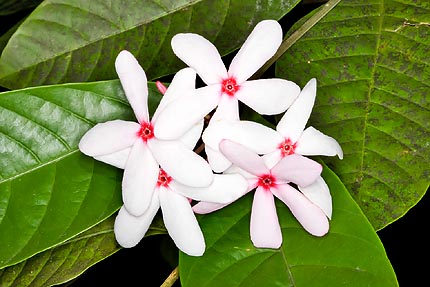Family : Apocynaceae

Text © Pietro Puccio

English translation by Mario Beltramini

Decorative, once used for poisoning arrows. Now medicinal © G. Mazza
The Kopsia fruticosa (Roxb.) A.DC. (1844) is native of the Myanmar.
The genus is honoured to the Dutch politician and botanist Jan Kops (1765-1849); the species Latin name “fruticosa” rich of buds, refers to the cespitose appearance.
Common names: “shrub-vinca”, “pink kopsia”, “kopsia merah”, “pink gardenia” (English); “vinca-arbustiva”, “copsia” (Portuguese).
Shrub or small evergreen tree, to 3-4 metres tall, shows opposite elliptic leaves of a glossy pale green colour, long up to about 20 cm and 8 cm wide. The inflorescences are terminal with flowers of a diameter of 5-6 cm, with oblong petals of a pink white or pink colour, tending to the dark pink or red at the centre, which recall those of the Catharanthus roseus, better known under its synonym Vinca rosea, from which comes one of its common names. The fruits are drupes, ellipsoid, about 2,5 cm long, 1-seeded. It reproduces by seed, cutting and marcot.
Very diffused and appreciated plant in its country of origin, and, generally, in south-eastern Asia, for its ornamental characteristics and the medicinal properties exploited in the traditional medicine; like many other Apocynaceae, in fact, all the parts of the plant contain potentially toxic substances (the leaves were utilized by natives for poisoning the points of the arrows), some of which are interesting, also, the “official” medicine. The plant can be cultivated in the tropical and subtropical areas, preferably in partly shaded location and on rich and draining soils; it is suitable also for the cultivation in pot.
Synonyms: Cerbera fruticosa Roxb. (1819); Calpicarpum roxburghii G.Don (1837); Kopsia roxburghii (G.Don) Pharm. ex Wehmer (1911); Kopsia vinciflora Blume (1826); Tabernaemontana rosea Ten. (1845); Tabernaemontana longiflora Rusby (1920).
→ To appreciate the biodiversity within the APOCYNACEAE family please click here.
